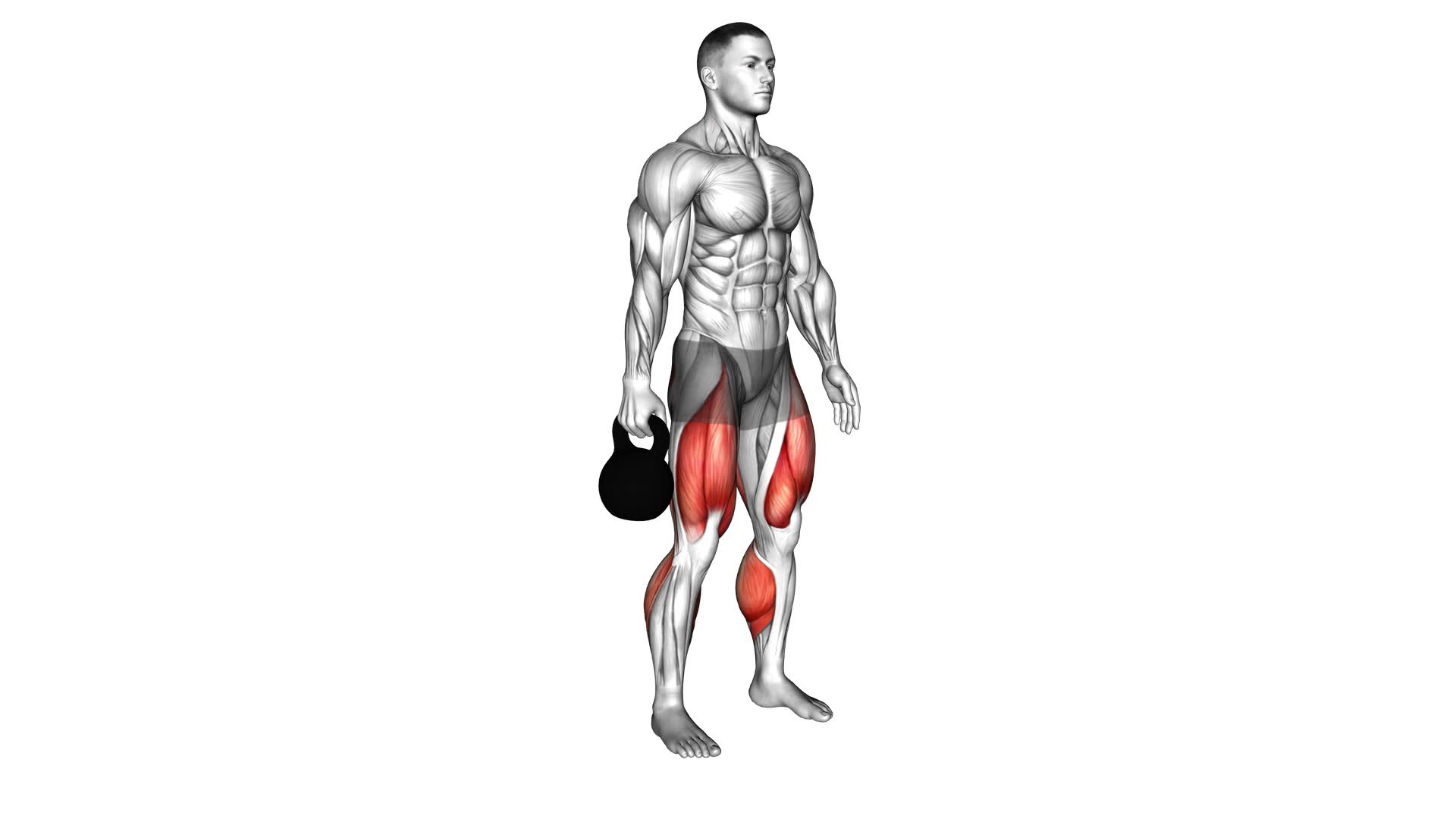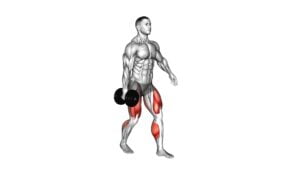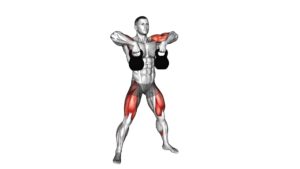Kettlebell Suitcase Deadlift (male) – Video Exercise Guide & Tips

Looking to strengthen your lower body and core? The kettlebell suitcase deadlift is a must-try exercise for you.
Watch This Exercise Video
In this video exercise guide, we'll show you the proper form and technique to get the most out of this exercise. You'll also find tips on increasing weight and intensity, as well as modifications for beginners and advanced lifters.
Avoid common mistakes and get ready to take your fitness routine to the next level with the kettlebell suitcase deadlift.
Key Takeaways
- Kettlebell suitcase deadlifts are highly effective for muscle activation and core stability.
- They engage multiple muscle groups simultaneously, targeting the posterior chain for overall strength and stability.
- Proper form and technique, including maintaining a strong grip and a neutral spine, are crucial for performing the exercise correctly.
- Gradually increasing weight and intensity while maintaining proper form can help to progressively overload the muscles and enhance the effectiveness of the exercise.
Benefits of Kettlebell Suitcase Deadlifts
You can experience several benefits from including kettlebell suitcase deadlifts in your workout routine. These exercises are highly effective for muscle activation and core stability.
When you perform a kettlebell suitcase deadlift, you engage multiple muscle groups simultaneously, including your glutes, hamstrings, quadriceps, and lower back. This exercise targets the posterior chain, which is crucial for overall strength and stability.
Muscle activation is a key benefit of kettlebell suitcase deadlifts. As you lift the kettlebell, your muscles work together to generate force and stabilize your body. This helps to improve overall strength and power. Additionally, the unilateral nature of this exercise forces each side of your body to work independently, which can help to correct muscle imbalances and improve overall symmetry.
Another benefit of kettlebell suitcase deadlifts is the impact they have on core stability. When you perform this exercise, your core muscles are engaged to maintain proper alignment and stability throughout the movement. This not only strengthens your core muscles but also improves your overall posture and balance.
Incorporating kettlebell suitcase deadlifts into your workout routine can provide numerous benefits for muscle activation and core stability. This exercise helps to target multiple muscle groups, improve strength and power, correct muscle imbalances, and enhance core stability.
Proper Form and Technique
To ensure proper form and technique for the kettlebell suitcase deadlift, focus on maintaining a strong grip on the kettlebell throughout the exercise. This will help you stabilize the weight and prevent it from swinging or slipping out of your hands. Here are some key tips to follow for proper technique:
- Stand with your feet shoulder-width apart and the kettlebell placed on the floor to the side of your feet.
- Bend at the hips and knees, keeping your back straight, and grab the kettlebell handle with one hand.
- Engage your core and glutes as you lift the kettlebell off the floor, using your legs to drive the movement.
- Keep your chest up and your shoulders back as you stand up, avoiding any rounding or hunching of the back.
- Hold the kettlebell close to your body, maintaining a neutral spine throughout the exercise.
Lower the kettlebell back down to the starting position with control, maintaining the same form and technique.
Avoid common mistakes such as rounding your back, using excessive momentum, or lifting too heavy of a weight.
Tips for Increasing Weight and Intensity
To increase the weight and intensity of the kettlebell suitcase deadlift, focus on gradually adding more resistance while maintaining proper form and technique. Increasing the weight will challenge your muscles and help you build strength. Start by selecting a kettlebell that's slightly heavier than the one you're currently using. This will allow you to progressively overload your muscles and stimulate growth. As you progress, continue to increase the weight in small increments to avoid straining your muscles.
In addition to increasing the weight, you can also vary your workout to increase the intensity. One way to do this is by incorporating different variations of the kettlebell suitcase deadlift. For example, you can try performing the exercise with a staggered stance, which will engage your core and stabilizer muscles even more. Another variation is to perform the exercise on an unstable surface, such as a Bosu ball or a foam pad. This will challenge your balance and increase the difficulty of the exercise.
Remember to always listen to your body and adjust the weight and intensity accordingly. It's important to find the right balance between pushing yourself and avoiding injury. By gradually increasing the weight and incorporating different workout variations, you can continue to improve your performance and make progress towards your fitness goals.
Modifications for Beginners and Advanced Lifters
For beginners, start with a lighter kettlebell and focus on mastering the proper form and technique of the kettlebell suitcase deadlift. This exercise can be challenging, but with the right modifications, you can gradually build strength and progress to more advanced variations.
Here are some modifications for both beginners and advanced lifters:
Beginner Modifications:
- Use a lighter kettlebell: Starting with a weight that's manageable for you'll allow you to focus on your form and technique without compromising your safety.
- Focus on proper body alignment: Make sure your back is straight, shoulders are pulled back, and core is engaged throughout the movement. This will help you maintain stability and prevent any unnecessary strain on your lower back.
- Perform partial range of motion: If you're finding it difficult to lift the kettlebell all the way up, start by performing partial reps. Gradually increase your range of motion as you get stronger.
Advanced Modifications:
- Increase the weight: As you become more comfortable with the exercise and your form is on point, you can gradually increase the weight of the kettlebell to continue challenging your muscles.
- Add a pause at the top: When you lift the kettlebell, hold it at the top for a few seconds before lowering it back down. This will increase the time under tension and intensify the exercise.
- Perform single-leg suitcase deadlifts: Instead of using both legs, try lifting the kettlebell while balancing on one leg. This will challenge your stability and engage your core muscles even more.
Common Mistakes to Avoid
Avoid these common mistakes when performing the kettlebell suitcase deadlift to ensure proper technique and maximize your results.
One common mistake is rounding your back during the movement. This puts excessive strain on your lower back and increases the risk of injury. Instead, focus on maintaining a neutral spine by engaging your core and keeping your chest lifted throughout the exercise.
Another mistake to avoid is using too heavy of a kettlebell. While it's important to challenge yourself, using a weight that's too heavy can compromise your form and lead to injury. Start with a lighter kettlebell and gradually increase the weight as your strength improves.
It is also common for people to neglect their hip hinge motion during the kettlebell suitcase deadlift. This movement is essential for targeting the posterior chain muscles, such as the glutes and hamstrings. To perform the hip hinge correctly, push your hips back and keep your knees slightly bent, allowing the kettlebell to lower down towards the ground while maintaining a straight back.
Lastly, avoid rushing through the exercise. The kettlebell suitcase deadlift should be performed with controlled, deliberate movements. Take your time to engage the correct muscles and maintain proper form throughout each repetition.
Frequently Asked Questions
How Many Calories Can You Burn Doing Kettlebell Suitcase Deadlifts?
When it comes to the number of calories you can burn doing kettlebell suitcase deadlifts, it's important to focus on the exercise itself. Proper form and technique are key to getting the most out of this exercise. By engaging your core and using your legs and glutes to lift the kettlebell, you'll be able to maximize calorie burn.
Additionally, there are variations of kettlebell suitcase deadlifts that can be tailored to different fitness levels, allowing for progression and continued calorie burn.
Can Kettlebell Suitcase Deadlifts Help With Improving Grip Strength?
Improving grip strength can be achieved through various kettlebell exercises. These exercises challenge your hand and forearm muscles, helping you develop a stronger grip.
Kettlebell suitcase deadlifts are an effective exercise for this purpose. By holding the kettlebell on one side of your body, you increase the demand on your grip strength to maintain stability.
Incorporating kettlebell suitcase deadlifts into your routine can help you build a stronger grip over time.
Is It Safe to Do Kettlebell Suitcase Deadlifts if You Have Lower Back Pain?
When you have lower back pain, it's important to prioritize safety when doing kettlebell suitcase deadlifts. While this exercise can be beneficial for grip strength, improper form can aggravate your condition.
Make sure to consult with a healthcare professional or a certified trainer who can guide you on the proper form for kettlebell suitcase deadlifts that will minimize strain on your lower back.
Safety should always be your top priority.
Can Kettlebell Suitcase Deadlifts Help With Improving Posture?
Kettlebell suitcase deadlifts are a great exercise to improve your posture. By engaging your core muscles, these deadlifts promote core stability, which is essential for maintaining proper posture.
Athletes can benefit from this exercise as it helps strengthen their core, allowing for better control and stability during sports activities.
Incorporating kettlebell suitcase deadlifts into your workout routine can help you develop a strong and upright posture, enhancing your overall athletic performance.
How Often Should Kettlebell Suitcase Deadlifts Be Incorporated Into a Workout Routine?
To maximize the benefits of kettlebell suitcase deadlifts, it's important to incorporate them into your workout routine regularly. The frequency will depend on your fitness goals and overall workout schedule. Ideally, aim to perform kettlebell suitcase deadlifts at least 2-3 times per week.
This will help improve your strength, stability, and posture. Remember to start with a weight that challenges you but allows for proper form. Gradually increase the weight as you progress to continue challenging your muscles.
Conclusion
In conclusion, the kettlebell suitcase deadlift is a highly effective exercise for building strength and stability in the lower body and core. By maintaining proper form and technique, increasing weight and intensity gradually, and making modifications if needed, you can maximize the benefits of this exercise.
Remember to avoid common mistakes such as rounding the back or using too much momentum. Incorporate kettlebell suitcase deadlifts into your workout routine to improve your overall strength and fitness.

Author
Years ago, the spark of my life’s passion ignited in my mind the moment I stepped into the local gym for the first time. The inaugural bead of perspiration, the initial endeavor, the very first surge of endorphins, and a sense of pride that washed over me post-workout marked the beginning of my deep-seated interest in strength sports, fitness, and sports nutrition. This very curiosity blossomed rapidly into a profound fascination, propelling me to earn a Master’s degree in Physical Education from the Academy of Physical Education in Krakow, followed by a Sports Manager diploma from the Jagiellonian University. My journey of growth led me to gain more specialized qualifications, such as being a certified personal trainer with a focus on sports dietetics, a lifeguard, and an instructor for wellness and corrective gymnastics. Theoretical knowledge paired seamlessly with practical experience, reinforcing my belief that the transformation of individuals under my guidance was also a reflection of my personal growth. This belief holds true even today. Each day, I strive to push the boundaries and explore new realms. These realms gently elevate me to greater heights. The unique combination of passion for my field and the continuous quest for growth fuels my drive to break new ground.







